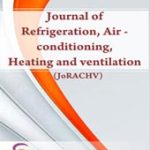Open Access

Amit Patil

Vinay Hogle

Vyankatesh Gaikwad

Sujal Randive

Rahul Thakare
- Professor Automobile Department, Saraswati College of Engineering, Navi Mumbai Maharashtra India
- Student Automobile Department, Saraswati College of Engineering, Navi Mumbai Maharashtra India
- Student Automobile Department, Saraswati College of Engineering, Navi Mumbai Maharashtra India
- Student Automobile Department, Saraswati College of Engineering, Navi Mumbai Maharashtra India
- Student Automobile Department, Saraswati College of Engineering, Navi Mumbai Maharashtra India
Abstract
Recent analysis that has given performance on the basis of thermal analysis of thermostat valve. Play an important role in automobile Cooling system. And its performance can change according to its different temperature conditions. Thermostat valve has been extensively study with the primary direction it’s Bring Down engine temperature and upgrade performance of engine. Thermostat valve play an important role in automobile cooling system for durable the engine temperature in working condition. In this spot we use computer model analysis and simulation to examine thermal changes in thermostat valve using two different apparatus/material for analysis of thermostat Valve thermal analysis and simulation display the thermal changes in thermostat valve and tell how it will effect on cooling system. In automobile engine, there was a cooling system which work as cooling to the all vehicle. In such system the thermostat valve is operating all the cooling system with help of wax which is present in charge cylinder. The wax having something different property which work as at time of high temperature as fluid and at time of low temperature as solid structure in cooling system. The thermostat is 10/heart of cooling system it’s because of the without thermostat the system will not work properly. The engine is a reciprocating device which is work on heat of the fuel crate heat which is control by the cooling system. There was two different type of cooling system one is water cooling system another one is air cooling system. Most probably for the giant engine the water cooling system is used which is give power lost to engine but its profitable for the engine life. Air cooling system is maintenance free which is profitable but its work on small size of engine just like two wheeler engine.
Keywords: Thermal change, cooling system, two material, stable, thermostat
References
1. Van Aken M, Willems F, de Jong DJ. Appliance of high EGR rates with a short and long route EGR system on a heavy duty diesel engine [SAE technical paper]; 2007.
2. Arcoumanis C, Kamimoto T. Flow and combustion in reciprocating engines. Springer Science+Business Media; 2009.
3. Brace CJ, Hawley G, Akehurst S, Piddock M, Pegg I. Cooling system improvements—assessing the effects on emissions and fuel economy. Proc Inst Mech Eng D. 2008;222(4):579–91. doi: 10.1243/09544070JAUTO685.
4. Brace CJ, Burnham-Slipper H, Wijetunge RS, et al. Integrated cooling systems for passenger vehicles [SAE technical paper]; 2001.
5. Brand D. Control-oriented modeling of NO emissions of SI engines [doctoral thesis]: Zurich. Swiss Federal Institute of Technology; 2005.
6. Choquet V. Integrated engine waste recovery by combustion of evaporated engine cooling and ranking bottom cycle, application to heavy duty engines [Master’s thesis]. KTH; 2014.
7. Ebrahimi RA. Effects of gasoline-air equivalence ratio on performance of an Otto engine. J Am Sci. 2010;6(2):131–5.
8. Ganesan V. Internal combustion engines. 5th ed. New Delhi: McGraw-Hill Education (India) Pvt Ltd; 2012.
9. Guzzella L. Modeling and control of advance propulsion system. Oil Gas Sci Technol. 2007;64(4):585–94.
10. Guzzella L, Onder C. Introduction to modeling and control of internal combustion engine systems. Springer Science+Business Media; 2009.
| Volume | |
| Received | April 20, 2021 |
| Accepted | May 10, 2021 |
| Published | May 10, 2023 |


